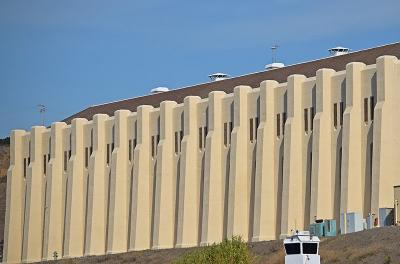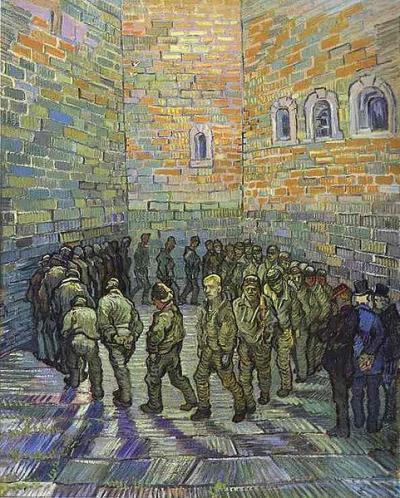All Souls Blog: Artful Punishment: The Curious Symbiosis Between Art and Imprisonment
Dr Anastasia Chamberlen is Associate Professor of Sociology at the University of Warwick. Her work has explored a range of different topics in relation to criminology, including prisons, the sociology of punishment, feminist theory, and, more recently, the connections between punishment and art in the carceral context. Dr Chamberlen presented some of her ongoing research on this theme at the final lecture of the All Souls Seminar of Hilary term 2021; considering the theoretical and methodological tensions and emancipatory potential of the ‘curious symbiosis’ between imprisonment and art.
Posted:
Time to read:
Art in Prisons
Prison sociology has remained relatively quiet about prison art, both as a theme, and as a method. The relationship between punishment and art in the carceral context, Dr Chamberlen contended, is under-theorised not only in the field of criminology, but also in the arts themselves. Dr Chamberlen therefore suggested three principal research questions. Firstly, we need to investigate the links between prison and art: what are the affective and structural arrangements that enable the arts to infiltrate prison walls, and how do those in prison engage with them? Secondly, we must consider how best to study this relationship theoretically and methodologically. Thirdly, we ought to consider prison art’s political utility: what potential does prison art hold for emancipation and resistance in relation to the prison?
So, what does art in prison look like today? Dr Chamberlen pointed to the rise of ‘art therapy’ in prisons and ‘artist in residence’ programmes. However, while these programmes may allow those in prison to express themselves creatively and can be used as a coping strategy, Dr Chamberlen was clear that we must view them with a critical eye. These programmes can also inadvertently be absorbed into disciplinary prison regimes in the name of effective punishment—Dr Chamberlen cited as an example prison officials’ power to control who gets to participate in these programmes and who does not. They are also frequently drawn into superficial neoliberal discourses of ‘empowerment’ as principles of care are co-opted in an attempt to individualise delinquency: the programmes prioritised by prison authorities are those that explicitly link the ‘healing power’ of art to particular metrics associated with desistance. Further, the proliferation of these programmes allows third sector organisations to consolidate their role as key actors in the ‘delivery’ of ‘rehabilitative services’.
Its domination by formal art programmes run by external facilitators also risks casting the arts in prison as something that only happens within such ‘official’ arts settings. American scholar Nicole Fleetwood, whose work focuses on the relationship between art and mass incarceration in the US, points out that most ‘art’ in prisons actually takes place in prison cells. Dr Chamberlen also stressed that recognising these individual efforts that go beyond organised arts programmes is crucial: often, art in prison happens in spite of, not because of the prison authorities’ gaze.

Prison Art and the Prison Artist in the Art World
Beyond the walls of the prison, Dr Chamberlen was also critical of the ways in which prison art is received (or not) in the art world and in wider society. She pointed out a taken-for-granted acceptance—perhaps even a fetishisation— in the middle-class imaginary of the link between isolation, incarceration, and creative production: an ‘idealised and unquestioned’ relationship. She drew on the example of a piece written for the Tate Modern website, published during the Covid-19 lockdown, suggesting that artistic inspiration could be found by Tate audiences in lockdown through artists who had produced work while incarcerated. This loose conception of isolation, and the assumed link between isolation and creativity, often leads to the neglect of the crucial element of punishment in prison art.

Crafting a Theory of Prison Arts: Elucidating the Links Between the Arts and Imprisonment
In order to craft a theory of prison arts, Dr Chamberlen discussed the embodied and affective nature of both art and punishment: crucially, pain is the substantive link between the two. Art can function as a medium for the expression of pain and as a means for survival. Recognition—and a focus on the complex identities and biographies of prison artists—is also key when working towards a theory of prison art. Dr Chamberlen suggested that this might be done by looking beyond the ‘established narratives’ of prison art, and taking an intersectional sociological (rather than purely aesthetic) appreciation of prison art.
Another essential element to consider is the economies of affect at play, as well as the interests and motivations of the institutions and powers enabling art in prison. Remaining vigilant in relation to the potential risks of art in prison is also crucial. Neoliberal drives for profit and the long history of the commodification of prison art (for example, San Quentin State Prison in California actually has a ‘gift shop’ where tourists can buy art made by people on death row) mean we must also remain attentive to the connections between the art world and the prison-industrial complex. In light of both the risks and promises of prison art, then, Dr Chamberlen suggested conceptualising art as both an unintended part of modern punishment as well as a potential antidote.
Challenging ‘Carceral Obsessions’
While Dr Chamberlen was clear about the need to be critical when thinking about the complex, often contradictory connections between punishment and art, she was also keen to highlight the promise of prison art to effectively inform public understandings of the inmate world. Prison art, therefore, holds emancipatory potential not just for the artist, but also for audiences, too—bringing discussions of punishment and the lived experience of pain and loss into the mainstream—and perhaps engaging with the wider public on the subject through a more successful political, activist agenda.

Keywords:
Share:
